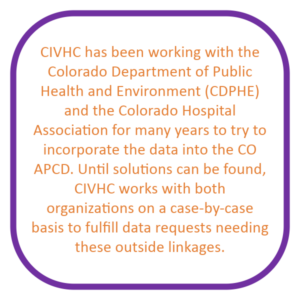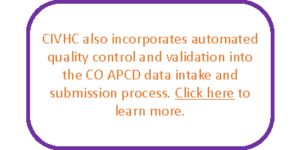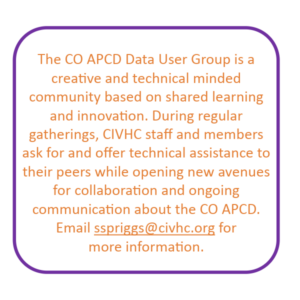Analyst: Trang Giang, MBA, Data Quality Analyst, CIVHC

Introduction: Why did you decide to go into health care analytics?
I got into health care analytics entirely by accident, and now it is my career as well as my passion. I graduated with a finance degree and an MBA, but the job hunt was not an easy road. I stumbled upon an opportunity at an analytics company providing business intelligence products for post-acute providers. Even though it was different from my major, my detail-oriented and analytical thinking mindset made it an easy fit. While there I learned about health care and how analytics can turn data into something meaningful that helps providers with patient care and business operations.
After two years, I joined Arkansas Center for Health Improvement (ACHI) and the Arkansas All Payer Claims Database (AR APCD) and was able to see how health care data can be utilized at a much bigger scale, advancing health care across the state and informing policy. After six years there and now with CIVHC, I truly think I am on the right career path to make a difference in the community.
1.) Can you tell us a bit about what you do each day at CIVHC? Is it different from what you did in Arkansas? Have you encountered any challenges transitioning from one APCD to another?
As a data quality analyst, I am responsible for monitoring the quality of the submission from the payers, proactively identifying any data issues, and assisting other analysts in their projects. My role at Arkansas was a little broader as everything was in house, and the team was smaller. As a technical business analyst, I was responsible for leading the intake of the data submission, quality control (QC) of the data warehouse refreshes and fulfilling data requests. What I enjoyed the most was submerging myself in the data and deep diving into the issues and solving them, which made the transition to my role at CIVHC smoother. Of course, there are challenges. Besides having to learn the new database structure (which most analysts would have to go through when starting a new job), I also have had to familiarize myself with new processes. As I mentioned, ACHI does everything in house, whereas CIVHC has a data warehouse vendor. That creates a new learning curve to understand the interaction between the teams and the processes of how responsibilities flow between the vendors and CIVHC. Fortunately, CIVHC has a tremendous amount of new hire training materials that have really supported the transition of my role.
2.) What similarities or differences have you noticed between the APCDs?
While not all APCDs are the same, CO and AR have similar legislative setups. Not only that, but the core content of the database is also the same. Both APCDs have final paid medical, pharmacy and dental claims, enrollment, and provider data. However, at a more detailed level, APCDs can vary based on the size, the governing rules, funding limitations, etc.. Some of the more interesting differences between CO and AR that I have observed thus far are the enhancements CIVHC makes to the database in the form of additional data sources and data processing. Some examples include:
- The CO APCD receives annual files for Alternative Payment Models (APM) and Drug Rebate data, but, unlike the AR APCD, CIVHC is currently unable to directly incorporate vital statistics data for Birth/Death Certificates, Cancer Registry, and Hospital Discharge data.
The CO APCD requires payers to submit files monthly, which minimizes the time delay of the database. The AR APCD, however, allows payers to submit files monthly or quarterly, which provides the payers flexibility and lessens the administrative burden. However, this also limits the timeliness of data warehouse refreshes.
3.) What do you think CIVHC could learn from how the AR APCD is structured and used?

As I mentioned, one of the strong points of AR APCD is the addition of other data sources that are linkable to the APCD. That helps increase the value of the database and widen the scope of the projects that it can support.
Additionally, AR APCD was built in-house. That allows for the flexibility of any modifications, and it also encourages the team members to have a comprehensive understanding of the data and its processes. That doesn’t diminish the advantages of having a third-party vendor, but it is an opportunity for the analysts at CIVHC to know how the data goes from A to Z and how their work impacts the database.
4.) Are there particular projects at either APCD that you’ve enjoyed working on?
Since I am fairly new at CIVHC, the first project that I am currently working on, is the data collection and validation of APM data. It has been a learning experience, as I was not familiar with this data source or APMs in general. In my with ACHI, my work emphasized data management more than reporting.
 At AR APCD, since their database is in-house and the team is relatively small, a tremendous amount of automation needs to be in place to support the database. One of the projects that I really enjoyed was creating an automation process for standard QC of the data warehouse refreshes. The audit steps were integrated into the database refreshes in the form of SSRS reports with parameters that the auditors would run after each build to identify issues and drill down. Not only did it cut the run time in half, but it also made sure that all audit checks are stored within the database for historical purposes.
At AR APCD, since their database is in-house and the team is relatively small, a tremendous amount of automation needs to be in place to support the database. One of the projects that I really enjoyed was creating an automation process for standard QC of the data warehouse refreshes. The audit steps were integrated into the database refreshes in the form of SSRS reports with parameters that the auditors would run after each build to identify issues and drill down. Not only did it cut the run time in half, but it also made sure that all audit checks are stored within the database for historical purposes.
5.) What do you see as the biggest opportunity CIVHC has to support Change Agents?
When I was at ACHI, one of the biggest users of the database was the University of Arkansas researchers. The data was accessed via a subscription-based data request that the students, faculty members and others could utilize for their research projects. At each data users group meeting, the projects were discussed, and ideas were bounced off between researchers. A lot of times, data issues and potential enhancements to the database were discovered that way. Something similar could be an opportunity for CIVHC to support Change Agents by putting the data out there and providing more access to organizations with a large population of researchers. In return, it is an opportunity to have more eyes on the data, improve its quality, and make it even richer.

